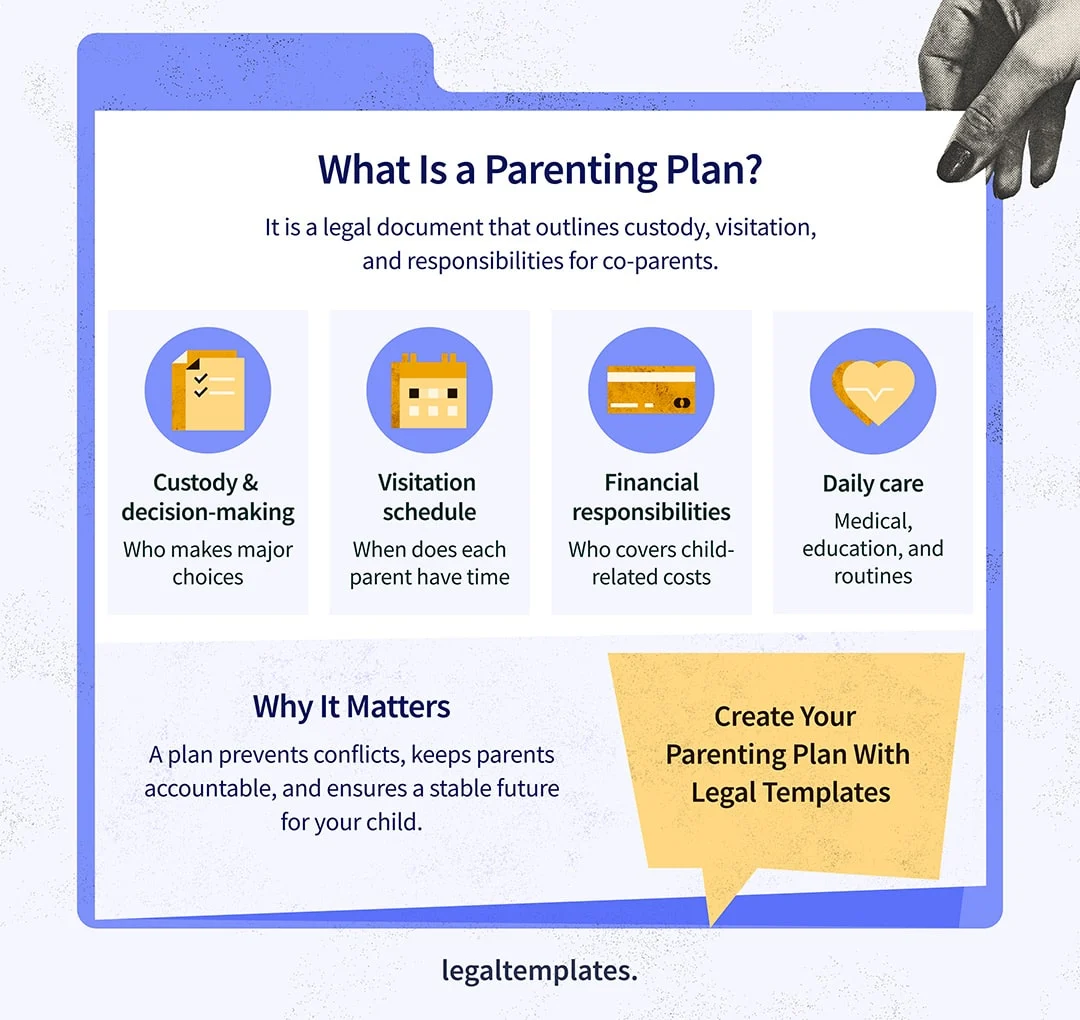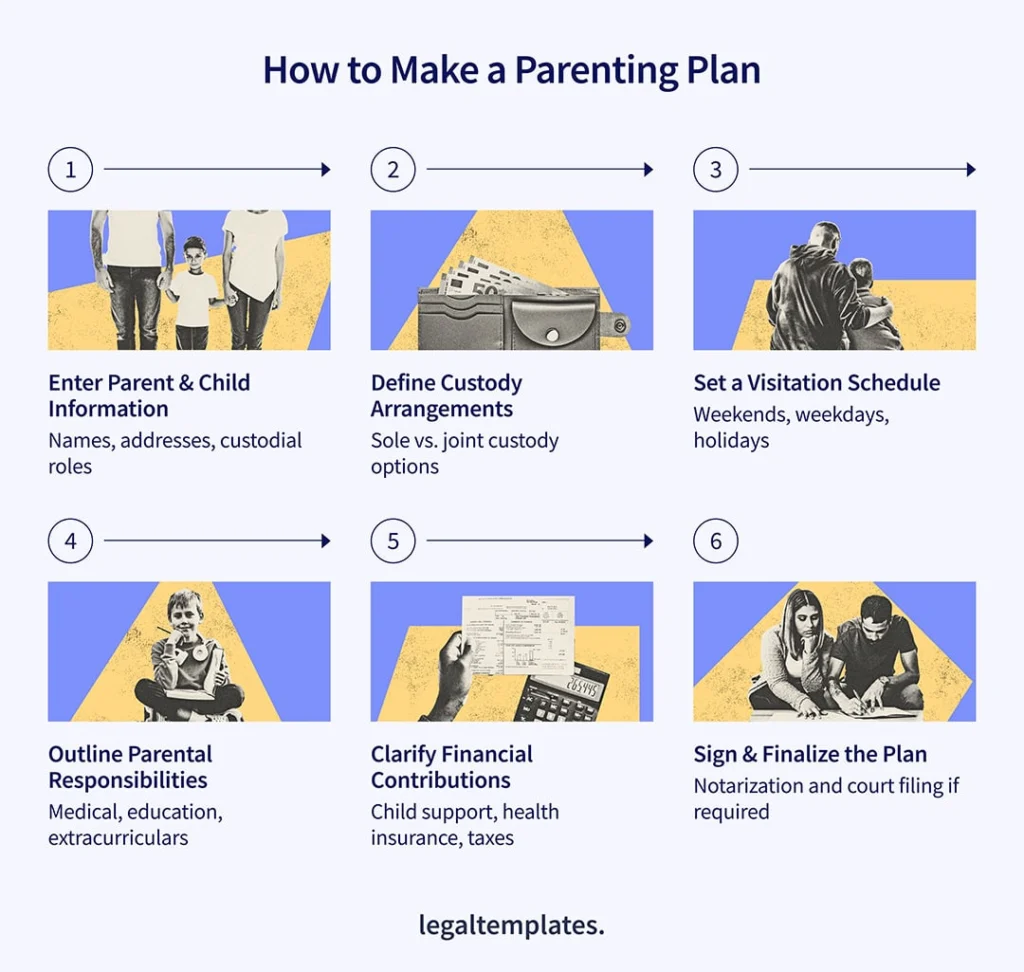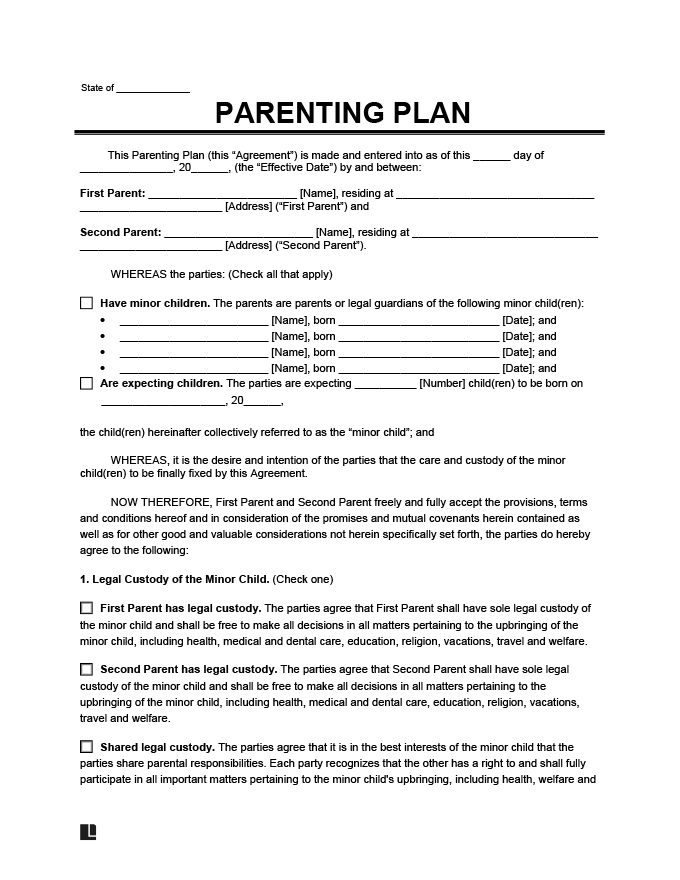What Is a Parenting Plan?

A parenting plan (or custody agreement) is a legal document that outlines how separated or divorced parents will share responsibilities for their child(ren). It covers:
- Legal & physical custody (who makes day-to-day decisions and where the child lives)
- Visitation schedules (including holidays and vacations)
- Child support & financial responsibilities
- Medical care, education, and daily needs
Once approved by the court, a parenting plan is legally binding. Both parents must follow its terms, and violations can result in legal consequences or modifications.
Separation & Divorce Agreements
Parenting plans are often included in a separation agreement or divorce agreement. If you need help navigating the divorce process, read our guide on how to legally separate and divorce.
Does a Parenting Plan Expire?
A parenting plan remains valid until the child turns 18 unless parents agree to changes or a court modifies it. Some states require renewals for certain provisions—check your local laws.
How to Make a Parenting Plan

Creating a parenting plan is essential for setting clear expectations between co-parents and ensuring a smooth co-parenting experience. With Legal Templates, you can quickly make a court-ready parenting plan that covers custody, visitation, and financial responsibilities—helping you avoid disputes and keep your child’s best interests at heart. Follow these simple steps to create a plan that works for your family.
1. Enter Parent & Child Information
Start by listing key details about both parents and children. This section ensures clarity and avoids disputes about parental roles, contact details, and child-specific information.
- Include both parents’ names and contact information
- Identify whether each parent is the custodial or non-custodial parent
- List each child’s name, birthdate, and primary residence
Using consistent terms like “custodial parent” and “non-custodial parent” keeps legal documents clear and enforceable.
2. Define Child Custody Arrangements
Your parenting plan should specify how decision-making and living arrangements will be handled. Courts prioritize arrangements that serve the best interests of the child.
| Custody Type | Description |
|---|---|
| Sole Legal Custody | One parent makes all major decisions. |
| Joint Legal Custody | Both parents share decision-making responsibilities. |
| Sole Physical Custody | Child primarily lives with one parent, with visitation for the other. |
| Joint Physical Custody | Child spends significant time with both parents. |
If you need a unique custody setup, Legal Templates lets you customize arrangements based on your family’s needs and your child’s preferences (when plausible).
3. Set a Visitation Schedule
A clear visitation schedule ensures both parents understand when they’ll get to spend time with their child, reducing conflicts and misunderstandings. If your child will be traveling without one or both parents, you may need a child travel consent form to provide legal permission for their trip.
Popular parenting schedules include:
- 50/50 custody: Alternating weeks or split weekdays/weekends
- 2-2-3 schedule: One parent has Monday & Tuesday, the other has Wednesday & Thursday, and they alternate weekends
- Every other weekend + one midweek visit
Holidays & summer breaks: Be sure to specify how major holidays, school vacations, and special occasions will be divided.
4. Define Parental Responsibilities
A strong parenting plan clearly defines each parent’s responsibilities to prevent future conflicts.
Decide on:
- Medical decisions: Who will manage healthcare and insurance?
- Education choices: Which parent will handle school enrollments and decisions?
- Extracurricular activities: How will sports, clubs, and other activities be divided?
If you ever need to authorize another adult—such as a grandparent or caregiver — to have medical decision-making authority, you can use a child medical consent form to ensure they have legal permission.
Adding a communication plan (calls, texts, or shared apps) helps co-parents stay informed about major decisions.
5. Outline Financial Contributions
Financial clarity is crucial in a parenting plan. Clearly define who is responsible for what expenses to avoid future disputes. If you need to adjust child support payments, ensure you follow the proper legal process. You can use a child support modification form to request changes to an existing court-ordered agreement.
Key financial considerations:
- Child support obligations (based on state guidelines).
- Who provides health insurance?
- How will school fees, extracurriculars, day care, and medical costs be split?
- Who claims the child on taxes?
How much does it cost to modify a parenting plan?
Costs vary by state—some modifications are free if both parents agree, while court-involved changes can range from $100 to $500+.
6. Sign & Finalize Your Plan
Once all details are agreed upon, finalizing your parenting plan properly ensures it holds up in court.
To finalize:
- Review the agreement to ensure both parents understand the terms
- Sign and date the document
- Submit to the court if required in your state
Do parenting plans need to be notarized?
In most states, notarization is not required, but having a witness or legal review strengthens enforceability.
Make your parenting plan today with Legal Templates and ensure it’s legally sound, enforceable, and built for your family’s needs.
Modifying & Enforcing a Parenting Plan
Parenting plans are meant to provide stability, but life circumstances change. Whether it’s a new job, relocation, or evolving needs of your child, you may need to modify your parenting plan. With Legal Templates, your document is securely saved to your account, making it easy to edit when required. However, any changes must still follow legal modification rules to remain valid.
Can You Modify a Parenting Plan Without Going to Court?
Yes—if both parents agree on the changes, you can update and sign a new parenting plan without court involvement. However, if there is disagreement or significant changes, you may need to request court approval to ensure the modifications are legally enforceable.
How to Modify a Parenting Plan
To update your parenting plan properly, follow these steps:
- Review the existing plan and identify what needs to change
- Discuss modifications with the other parent—mediation can help if you disagree
- Update your parenting plan using Legal Templates, where your document is securely saved for easy edits
- Check your state’s requirements—some changes may need court approval
- Submit a modification request to the court if necessary
Common Reasons to Modify a Parenting Plan
Life changes can impact custody, visitation, or support arrangements, making it necessary to update your parenting plan.
- Relocation: One parent moves out of state
- Work schedule changes: Affecting custody or visitation times
- Child’s safety or well-being: If new concerns arise with domestic violence or child abuse, modifications may be needed
Parenting Plan Sample
Below, you can view a sample parenting plan. You can customize this parenting plan template using our document editor, then you can download in PDF or Word format.





